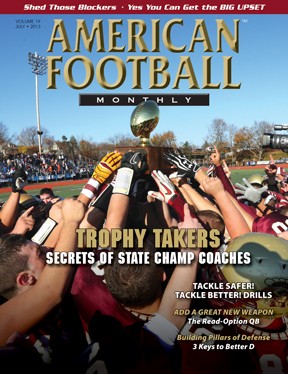Article CategoriesAFM Magazine
|
Speed Report – Dynamic Relaxation – The Misunderstood Nugget for Speed and Quicknessby: Dale BaskettFootball Speed Specialist © More from this issue When we think of the word relaxation it doesn’t suggest a very aggressive picture in our mind. Whenever I mention the term “Dynamic Relaxation” to coaches, they’re momentarily puzzled. They are searching their thoughts for where this picture fits football, a sport that delivers aggressive action every play. Football movement is not naturally linked to relaxation when the game is all about contact. Having a consistent forceful mindset week to week is what every coach desires. However, this isn’t the prescription for maximizing quickness or limb speed. The key is getting your players to perform consistently fast every play. The first order of business is speed development using a bio-mechanically controlled systematic package that provides dynamic relaxation within the scheme. What is dynamic relaxation exactly and how does it work? It’s the ability to run aggressively at varying frequencies without muscling or forcing the activity of limb movement. It’s a learned skill that is currently absent in the football world. What makes it tricky to teach is the fact that football has so many variable movement actions involved. There is bad news, as well. If you use steep hills, over-weighted sleds or anything along these lines, you can be assured that dynamic relaxation will be difficult. They are counter-productive for the relaxed intensity desired. Our applications for development are sometimes skewed due to staying inside the box. That is, focusing on a notion or portion of a movement we wish to help while not realizing at the same time we’re hammering one or two other techniques valuable to speed and movement. My efforts are to lend good sound principles that make football speed come alive. This particular technical skill will be worth the time spent to perfect it. I will be giving you some good sound drills to help you bring about this most important nugget for playing faster. Speed components make a difference if you use methods that are technically sound and thorough.
Diagram # 1: Release at easy stride pace and be relaxed at 60%. The burst will be the key that takes place next, limb quickness at the point of burst assertion, not muscling the ballistic burst needed. A decel will follow with the mental focus relaxed and visualizing on the upcoming impact of a quick limb burst again. As a coach, you need to look carefully at the over tensing aspect that may be present initially. It will get better as you work through the days and reps.
Diagram # 2: Lateral easy at 60% with the same principles applying for quickness as directed in diagram #1. The difference is lateral speed work, not lineal.
Diagram # 3: Angle downhill with a fast sprint angle and relaxed with a quick approach. Plant quick (extension plant), and immediately decel limb speed to a short turnover, staying relaxed once again. Plant a second time to a full burst sprint, then repeat plant to decel, this time to a longer sprint finish.
Diagram # 4: Long sprint applying relaxation and limb speed. Decelerate, back to quick relaxed burst to relaxed but a dynamic sprint. This drill is quite simple because it offers only lineal speed with minimal movement changes.
Diagram # 5: This drill is very lineal, as well, but offers up a challenge of quick response changes due to short zone lengths. The cones will come at the athletes rapidly and concentration should be focused on the quick response of limb rotation, then to a slower decel, and back to quick again. This is the hardest drill to perform well because of the sudden changes of limb speed. Coach Baskett began his career as a football speed coach in 1979. During the last 34 years he’s consulted and trained hundreds of coaches and thousands of athletes nationwide. In the last year he has worked directly with high schools in California, Texas, Minnesota, Kansas, and Pennsylvania. Over the last few years he has also consulted with Texas Tech, Ohio State, USC, University of Washington, and the University of Mount Union. You can reach him directly for more information or if you have specific questions on your training program. Coach Baskett is at dbspeedt@hotmail.com and 858-568-3751. |
|
| HOME |
MAGAZINE |
SUBSCRIBE | ONLINE COLUMNISTS | COACHING VIDEOS |
Copyright 2024, AmericanFootballMonthly.com
All Rights Reserved









